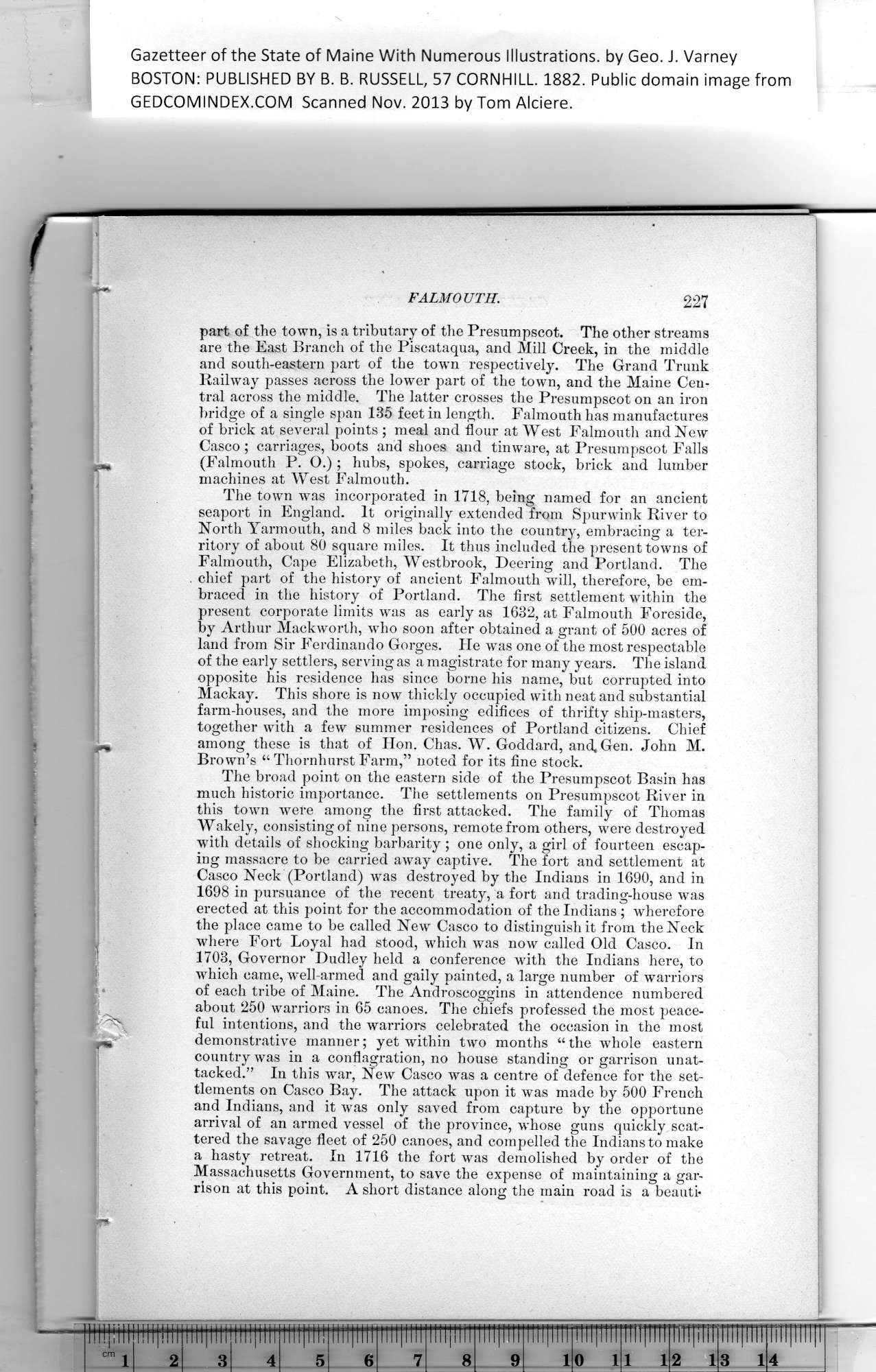|
Gazetteer of the State of Maine With Numerous Illustrations, by Geo. J. Varney
BOSTON: PUBLISHED BY B. B. RUSSELL, 57 CORNHILL. 1882. Public domain image from
FALMOUTH.
part of the town, is a tributary of the Presumpscot. The other streams
are the East Branch of the Piscataqua, and Mill Creek, in the middle
and south-eastern part of the town respectively. The Grand Trunk
Railway passes across the lower part of the town, and the Maine Cen-
tral across the middle. The latter crosses the Presumpscot on an iron
bridge of a single span 135 feet in length. Falmouth has manufactures
of brick at several points ; meal and flour at West Falmouth and New
Casco ; carriages, boots and shoes and tinware, at Presumpscot Falls
(Falmouth P. O.) ; hubs, spokes, carriage stock, brick and lumber
machines at West Falmouth.
The town was incorporated in 1718, being named for an ancient
seaport in England. It originally extended from Spurwink River to
North Yarmouth, and 8 miles back into the country, embracing a ter-
ritory of about 80 square miles. It thus included the present towns of
Falmouth, Cape Elizabeth, Westbrook, Deering and Portland. The
chief part of the history of ancient Falmouth will, therefore, be em-
braced in tbe history of Portland. The first settlement within the
present corporate limits was as early as 1632, at Falmouth Foreside,
by Arthur Mackworth, who soon after obtained a grant of 500 acres of
land from Sir Ferdinando Gorges. He was one of the most respectable
of the early settlers, serving as a magistrate for many years. The island
opposite his residence has since borne his name, but corrupted into
Mackay. This shore is now thickly occupied with neat and substantial
farm-houses, and the more imposing edifices of thrifty ship-masters,
together with a few summer residences of Portland citizens. Chief
among these is that of Hon. Chas. W. Goddard, and. Gen. John M.
Brown’s “Thornhurst Farm,” noted for its fine stock.
The broad point on the eastern side of the Presumpscot Basin has
much historic importance. The settlements on Presumpscot River in
this town were among the first attacked. The family of Thomas
Wakely, consisting of nine persons, remote from others, were destroyed
with details of shocking barbarity; one only, a girl of fourteen escap-
ing massacre to be carried away captive. The fort and settlement at
Casco Neck (Portland) was destroyed by the Indians in 1690, and in
1698 in pursuance of the recent treaty, a fort and trading-house was
erected at this point for the accommodation of the Indians ; Avherefore
the place came to be called New Casco to distinguish it from the Neck
where Fort Loyal had stood, which was now called Old Casco. In
1703, Governor Dudley held a conference with the Indians here, to
which came, W’ell-armed and gaily painted, a large number of warriors
of each tribe of Maine. The Androscoggins in attendenee numbered
about 250 warriors in 65 canoes. The chiefs professed the most peace-
ful intentions, and the warriors celebrated the occasion in the most
demonstrative manner; yet within two months “ the whole eastern
country was in a conflagration, no house standing or garrison unat-
tacked.” In this war, New Casco was a centre of defence for the set-
tlements on Casco Bay. The attack upon it was made by 500 French
and Indians, and it was only saved from capture by the opportune
arrival of an armed vessel of the province, whose guns quickly scat-
tered the savage fleet of 250 canoes, and compelled the Indians to make
a hasty retreat. In 1716 the fort was demolished by order of the
Massachusetts Government, to save the expense of maintaining a gar-
rison at this point. A short distance along the main road is a beauti*
PREVIOUS PAGE ... NEXT PAGE
This page was written in HTML using a program written in Python 3.2
|
